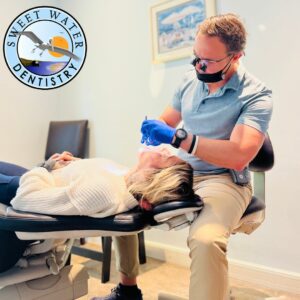Fairhope Dentist Sealants

Overview
Dental sealants or Tooth sealants are plastic coatings that protect the chewing surfaces of your teeth from bacteria and plaque that cause tooth decay. These are mainly applied to the grooves of your back teeth – premolars and molars – wherein decay occurs frequently. You will find that most of the tooth decay that occurs in children as well as teens happens in these tooth surfaces. Application of this coating protects chewing surfaces from germs as well as food items sticking to the grooves of these teeth. The best way to protect the permanent teeth of your child is to apply dental sealant. Adults can also benefit from this. In the US insurance companies pay for the application of a dental sealant on children’s teeth, but they don’t cover adult teeth.
Caries Prevention
The dental sealants are plastic resins and they can be bonded into the fissures and pits of the tooth to make the tooth surface smooth; this will facilitate the bristles of the toothbrush from accessing all areas of your tooth and removing the plaque thereby preventing tooth decay. Another problem that you could face is that the thickness of the enamel layer in the fissures and pits is lesser than that in the other parts of the tooth. This means that this area is not only susceptible to cavity formation but also the cavities will penetrate the enamel layer in a shorter period. The teeth that are likely to benefit from the application of this plastic coating are the permanent molars. It is ideal if you get the sealant applied immediately after the eruption of teeth and this will prevent tooth decay.
Sealant application
The process of application of sealants is relatively simple and does not warrant any drilling or removal of tooth structure. The whole process might take a few minutes for every tooth. Sealants are capable of withstanding normal chewing pressures. The sealant normally remains intact for 5-10 years and as long as the sealant remains the surface of your tooth will not decay; you may require a second application only after several years after consulting with your dentist.
Dental sealants and aesthetics
The existence of sealants in your mouth can be seen by others only if they observe it closely. Sealants come in different shades such as clear, white, slightly tinted, etc., and hence cannot be seen while talking or smiling. However, you can feel the existence of the sealant with your tongue.
Dental sealants or Fluoride
It is not possible to replace fluorides with dental sealants. They have to work in conjunction with each other to prevent tooth decay. Sealants prevent the accumulation of germs and food particles out of the grooves.
Cavity filling VS sealant application
Sealant application is a preventive process whereas filling is the treatment carried out after your tooth is damaged because of tooth decay. Filling weakens your tooth because every time filling is done the dentist drills your teeth. You can save money, time, and discomfort with dental sealants as compared to fillings.
Risk Factors
Most of the sealant materials contain BPA – Bisphenol A – and this is an endocrine disruptor that causes negative health effects. FDA is also concerned about its exposure to fetuses, children, and infants. However, recent studies have shown that dental sealants can be used safely on kids as long as the dentists ensure that all the residues of the sealants are rinsed or wiped out after application. On the other hand, the researchers of this study think that using sealants on pregnant women is to be avoided as far as possible unless the treatment is an absolute necessity.
Visit us for expert care:
Sweet Water Dentistry
📍 5915 Sweetwater Cir, Fairhope, AL 36532
🌐 sweetwatersmile.com
📞 Call or Text: (251) 210-2773
Follow us on Facebook and Instagram for the latest updates and special offers!
